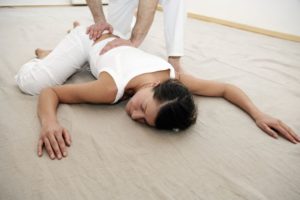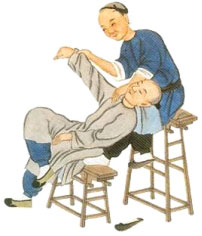Asian Bodywork Therapy (ABT) is the treatment of the human body/mind/spirit, by using pressure and/or manipulation and is based upon Chinese Medical principles for assessing and evaluating the body’s health. It uses traditional Asian techniques and treatment strategies for the purpose of treating the human body, emotions, mind, energy field and spirit for the promotion, maintenance and restoration of health.
 There are several forms of ABT recognized by the American Organization for Bodywork Therapies of Asian (AOBTA)®. Joe is a long-time professional member of the AOBTA®, and was originally trained in Jin Shin Acupressure and Zen Shiatsu, both Japanese-influenced forms of ABT, but it was the Chinese method called Tui Na that called to him, and which he began studying it in earnest in 1998. In addition, Joe is trained and certified in Western massage modalities, including myofacial release, circulatory massage, and sports massage, and holds Board Certification from the National Certification Board for Therapeutic Massage & Bodywork. He is also a California Certified Massage Therapist (CMT 12010), and integrates both Eastern & Western techniques into treatment sessions.
There are several forms of ABT recognized by the American Organization for Bodywork Therapies of Asian (AOBTA)®. Joe is a long-time professional member of the AOBTA®, and was originally trained in Jin Shin Acupressure and Zen Shiatsu, both Japanese-influenced forms of ABT, but it was the Chinese method called Tui Na that called to him, and which he began studying it in earnest in 1998. In addition, Joe is trained and certified in Western massage modalities, including myofacial release, circulatory massage, and sports massage, and holds Board Certification from the National Certification Board for Therapeutic Massage & Bodywork. He is also a California Certified Massage Therapist (CMT 12010), and integrates both Eastern & Western techniques into treatment sessions.
Zen Shiatsu
 Zen Shiatsu is characterized by the theory of Kyo-Jitsu, its physical and psychological manifestations, and its application to abdominal (Hara) diagnosis. Zen Shiatsu theory is based on an extended meridian system that includes, as well as expands, the location of the traditional acupuncture meridians. The focus of a Zen Shiatsu session is on the use of meridian lines rather than on specific points. In addition, Zen Shiatsu does not adhere to a fixed sequence or set of methods that are applied to all similar client needs. It utilizes appropriate methods for the unique pattern of each individual. Zen Shiatsu was developed by Shizuto Masunaga.
Zen Shiatsu is characterized by the theory of Kyo-Jitsu, its physical and psychological manifestations, and its application to abdominal (Hara) diagnosis. Zen Shiatsu theory is based on an extended meridian system that includes, as well as expands, the location of the traditional acupuncture meridians. The focus of a Zen Shiatsu session is on the use of meridian lines rather than on specific points. In addition, Zen Shiatsu does not adhere to a fixed sequence or set of methods that are applied to all similar client needs. It utilizes appropriate methods for the unique pattern of each individual. Zen Shiatsu was developed by Shizuto Masunaga.
Jin Shin Acupressure
Jin Shin Do® means “The Way of the Compassionate Spirit.” Jin Shin Do® Acupressure uses gentle yet deep finger pressure on specific acu-points and verbal Body Focusing techniques, to help release “armoring” or chronic tension, balance the “Qi” or energy, and improve vitality. This clothes-on method helps relieve stress- and trauma- related problems. A unique synthesis of a traditional Japanese acupressure technique, classic Chinese acupuncture and acupressure theory, Qigong (breathing and exercise techniques), and principles of Ericksonian psychotherapy, it is recognized as a major form of Asian Bodywork Therapy. Originated by psychotherapist Iona Marsaa Teeguarden, JSD® Acupressure promotes a pleasant trance-like state, in which one can relax and move out of the head and into the body, accessing feelings and inner wisdom. In its most basic form, JSD® is a simple, easy to learn, valuable self-help tool that can be shared with family and friends. In the hands of a skilled and sensitive practitioner, it can be a powerful, profoundly effective, transformative tool, which is easily incorporated into other therapeutic methods.
Tui Na Manual Therapy
 Tui Na (推拿) is a therapeutic form of massage and has been documented in use in China for more than 2,000 years, and is said to be the forerunner of modern chiropractic care. It is characterized by the smooth gliding or rolling movements of the hands and arms. Through Tui (push) and na (grasp), kneading, pressing, rolling, shaking, and stretching of the body, acupoints are opened and qi flow is realigned in the tendo-musculo meridians (TMMs). Tuina techniques are used to treat a wide variety of musculoskeletal and internal organ disorders by opening stagnant meridian channels and encouraging the flow of qi into deficient areas. Tuina utilizes Chinese Medicine theory in assessing energetic and functional disorders. In addition, the use of external herbal medicines and therapeutic exercise is also included. Tui na practitioners in China serve as orthopedic specialists, and practice bone setting and joint manipulations that are the purview of chiropractors and osteopathic physicians here in the U.S.
Tui Na (推拿) is a therapeutic form of massage and has been documented in use in China for more than 2,000 years, and is said to be the forerunner of modern chiropractic care. It is characterized by the smooth gliding or rolling movements of the hands and arms. Through Tui (push) and na (grasp), kneading, pressing, rolling, shaking, and stretching of the body, acupoints are opened and qi flow is realigned in the tendo-musculo meridians (TMMs). Tuina techniques are used to treat a wide variety of musculoskeletal and internal organ disorders by opening stagnant meridian channels and encouraging the flow of qi into deficient areas. Tuina utilizes Chinese Medicine theory in assessing energetic and functional disorders. In addition, the use of external herbal medicines and therapeutic exercise is also included. Tui na practitioners in China serve as orthopedic specialists, and practice bone setting and joint manipulations that are the purview of chiropractors and osteopathic physicians here in the U.S.
